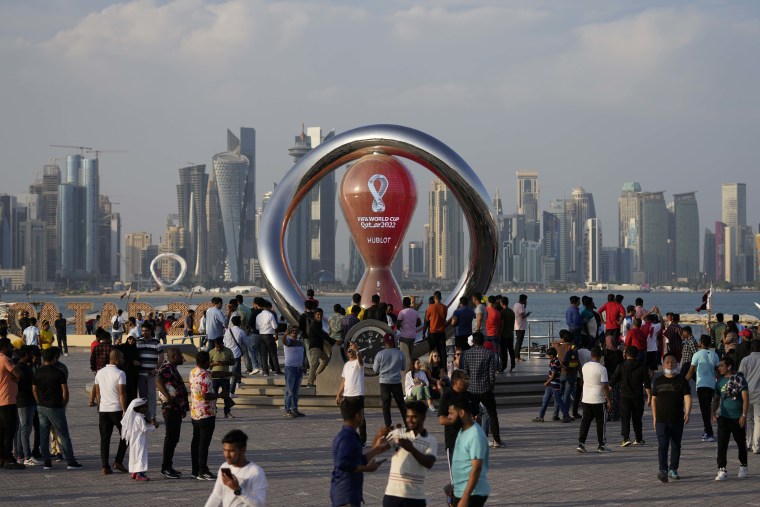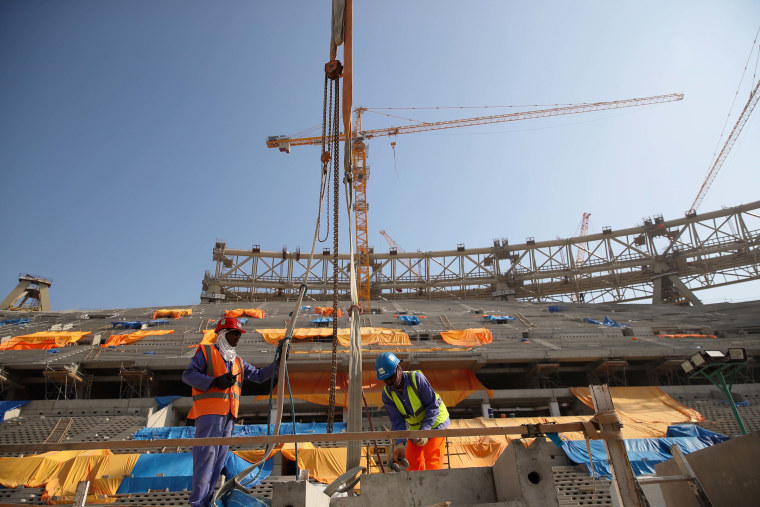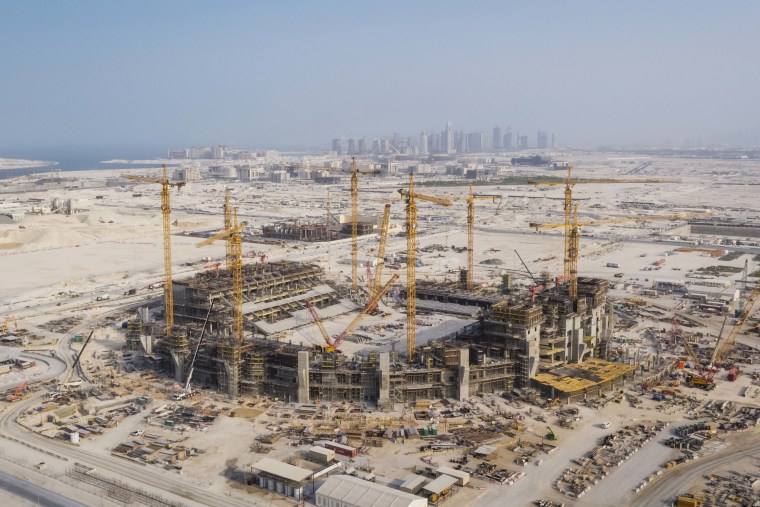Air conditioning in huge open-air stadiums, hundreds of international flights, lots and lots of lights.
More than a million people have traveled to Qatar for one of the planet’s biggest sporting events. But as it hosts the soccer World Cup, controversy is also descending on the tiny Gulf kingdom.
Alongside concerns over human rights, anti-LGBTQ laws and the treatment of migrant workers — issues that have dogged the tournament for years — critics say Qatar 2022 will be one of the most environmentally damaging of modern times.
Ahead of the tournament, several ecologically minded professional players signed an open letter to FIFA early this month, urging soccer’s global organizing body to ditch its contested claim that the Qatar World Cup is carbon neutral and to review its plans for next year’s Women’s World Cup hosted by Australia and New Zealand.
“The tournament has been labeled as the first ‘fully carbon neutral FIFA World Cup tournament,’ meaning its overall impact on the planet should be zero,” the letter said. “But that’s not true.”
“In reality, FIFA’s sustainability strategy for the Qatar World Cup rests on flawed carbon calculations, questionable offsetting practices, and shifting the responsibility onto fans rather than shouldering it themselves,” it added.
FIFA has said it has in place a “comprehensive set of initiatives … to mitigate the tournament-related emissions.”
The environmental cost of the tournament has crystallized the eco-anxiety for many following a year of unusually extreme weather and climate events around the world, such as droughts, wildfires and floods. And this is hitting the World Cup brand where it hurts the most — its fans. Some bars and pubs in countries including Britain, France and Germany have announced they won’t show the games, due to a mixture of worries over environmental damage and human rights abuses.
Almost half the pubs polled by Morning Advertiser, Britain’s pub industry trade magazine, said they would not show live matches. The Mustard Pot in Leeds blamed Qatar’s “pretty horrific” human rights abuses for its boycott, while the Liverpool Arms in the city of Chester told the magazine it had taken the decision because of Qatar’s lack of LGBTQ rights.
German broadcaster Deutsche Welle reported that dozens of venues in the German city of Cologne would also boycott the tournament because of Qatar’s rights record.
And retired soccer player Kevin Grosskreutz, a member of Germany’s World Cup winning squad in 2014, also wrote in an Instagram post that Mit Schmackes, the pub he owns in Dortmund, would not show matches even if it meant losing money.
The issue has touched a nerve among more casual World Cup observers, too.
La Cite Fertile, a cultural space in northern Paris dedicated to environmental and social issues, will instead show a rerun of the final match of the 1998 tournament in France, when a famously gifted French team beat Brazil to win the trophy for the first time.
Valentine Serac, 29, who works for an events agency in the French capital, said she planned to attend the rerun, but not any events to do with this year’s tournament.
“This summer was one of the most devastating ever in the world,” she said in a telephone interview. “We saw terrible images from the four corners of the Earth, we’re all becoming eco-anxious while they’re living in a different dimension where global warming does not seem to exist.”
“I’m not sure why I should support this bull—- actually. That would be admitting that it’s not too bad.”
Paris and Berlin are among several European cities that have said they will not be organizing a “fan zone,” a fixture at several previous tournaments where supporters can gather to watch games on a large screen, due to fears over the treatment of LGBTQ people in Qatar, rights for migrant workers and the environmental impact.
Calling the tournament a “human and environmental disaster,” Marseille Mayor Benoît Payan said in a statement last month that his city in southern France would do likewise. He added that it was “incompatible with the values we want to see conveyed through sport and especially football.”
FIFA, which usually releases viewer numbers after tournaments are over, did not respond to questions about how many viewers were tuning in from around the world.

Staying cool
Qataris have always had to contend with stifling heat. Many others are not so comfortable with these conditions, however.
So, it is no surprise that the original plans to stage this year’s World Cup during the summer — when temperatures can reach over 104 degrees Fahrenheit — were eventually ditched. But with temperatures even in November reaching as high as 90 degrees, air conditioning has been used in stadiums throughout the tournament so far. Some fans and journalists have even complained of being too cold during night games as a result.
“We shouldn’t have air-conditioned stadiums in the middle of the desert,” said Gilles Dufrasne from Carbon Market Watch, a nonprofit group based in Brussels that tracks the price of carbon trading. The organization is one of several that has complained to European regulators about allegedly misleading and false carbon neutral claims.
He added that the carbon impact of this would pale in comparison to flying a million people to Qatar and building seven stadiums.
No choice but to fly
Travel will account for half of the World Cup’s entire carbon footprint, according to FIFA — a figure inflated by the fact that Qatar is too small to accommodate all the fans: some will have to stay in the neighboring United Arab Emirates, a short one-hour flight or a grueling 6-hour drive through the desert. The state-owned Qatar Airways has increased its shuttle flights between Qatar and the UAE.
“We have reduced and withdrawn from 18 destinations in order to make space at Hamad International for new airlines to come that will bring fans,” Qatar Airways CEO Akbar Al Baker told a press conference in October.
Julien Jreissati, a director at the Greenpeace campaign group, said it was unlikely that the increase in Qatar Airways flights was part of FIFA’s estimation of 3.6 megatons of carbon dioxide emitted during the championship, adding more uncertainty around the numbers released by the organizing body.
Representatives for FIFA, King Hamad Airport and Qatar Airways did not respond to multiple requests for comment on the carbon footprint that the increased number of flights were expected to produce during the tournament.
After winning the right to host the tournament, Qatar pledged to become the first carbon neutral World Cup host.
“A comprehensive set of initiatives have been implemented to mitigate the tournament-related emissions — including energy efficient stadiums and green-building certification of their design, construction and operations, low-emission transportation, and sustainable waste management practices,” FIFA said in a statement to NBC News in November.
But experts have questioned whether the tournament should be taking place in such an arid country that has had to build seven new stadiums and renovate one. The country has also built a new metro rail system and constructed hundreds of new hotels, according to FIFA.
FIFA has stated that the total greenhouse emissions from the tournament will be equivalent to 3.6 million tonnes (or 5.4 million tons) of carbon dioxide, which will be entirely offset and mitigated by “low-carbon solutions” in Qatar and the Gulf region.
But Dufrasne from Carbon Market Watch said the organizers’ carbon neutral claim stems from spreading emissions from the construction over the stadiums’ 60-year life span — essentially cheating the math.
“From the total emissions associated with the construction of these new stadiums, they take responsibility for a share that is one month divided by 60 years,” he said.
Others agree. In November a series of climate-focused think tanks and campaign groups submitted complaints to advertising regulators in five European countries, regarding what they called FIFA’s misleading and false carbon neutral claim.

The complaints, made by The New Weather Institute in Britain, Klima-Allianz Schweiz in Switzerland, Notre Affaire a Tous in France, Carbon Market Watch in Belgium and Fossil Free Football in the Netherlands, said the organizers had underreported the level of emissions and had made misleading claims.
One of the ways FIFA aims to offset the tournament’s carbon footprint is through buying carbon credits. Through its own agency, the Global Carbon Council, Qatar says it invests in sustainable projects to pay its environmental debt. So far, as part of its pledge, Qatar has inaugurated renewable energy projects in Turkey and Serbia.
But the carbon credit market is not strong enough for the World Cup organizers to offset the tournament’s emissions and campaigners are worried about the message the carbon neutral claims sends out, Dufrasne said.
“There is definitely a risk around incentives that this sends … [that] you can continue to fly all the way to Qatar and watch football matches in brand new stadiums in the middle of the desert without any impact on the climate,” he said.
Jreissati of Greenpace also pointed out the hypocrisy of a state whose wealth is almost solely based on fossil fuels investing in carbon reduction schemes elsewhere.
“Let’s be clear: their bread and butter, their main source of income, every quarter comes from oil and gas,” he said. “And if investing in renewable energy is not part of a very clear systemic change … where they would transition away gradually but completely away from fossil fuel, then yes, this is a problem.”
He added that oil-rich states such as Qatar could use green schemes to polish their images and grant themselves more moral licenses to keep expanding their oil and gas exploration — a process known as “greenwashing.”
While concerned with the climate impact, Jreissati said, he did not want to be a killjoy.
“Events like the World Cup, like the football World Cup or like the Olympics bring joy and happiness to millions of people, sometimes even billions of people, right?” he said.
However, he said, he wished the controversy around the environmental impact of the tournament could spark conversations leading to improvements for future events.
“The hope is that all the scandal it has generated should be a very strong signal for both the host country Qatar and FIFA to engage in real transformative, systemic change towards a future which is greener, more sustainable and more peaceful.”

